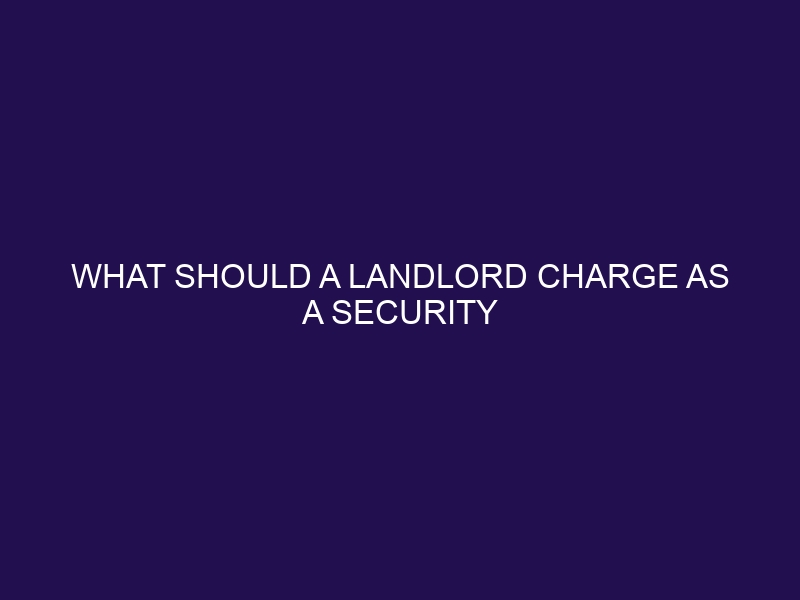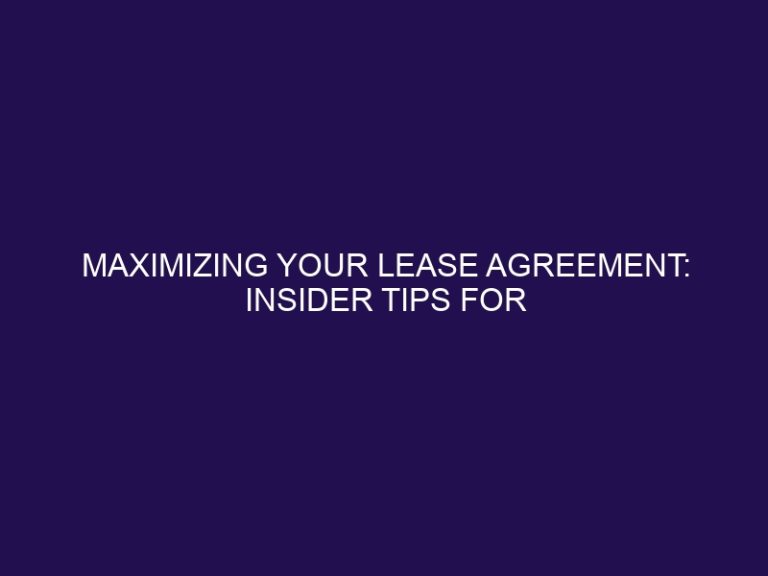What Should a Landlord Charge As a Security Deposit?
A security deposit is a sum of money that a landlord requires from a tenant in addition to the first month’s rent as a form of protection against any damages or unpaid rent. It is a common practice in the rental market and is meant to provide financial security to the landlord. However, landlords must follow certain guidelines when charging for a security deposit.
The amount of a security deposit can vary, but it is typically equal to one to two months’ worth of rent. The exact amount may depend on various factors, including the rental market in the area, the tenant’s credit history, and the condition of the property. For instance, a landlord may charge a higher security deposit for a tenant with a history of late payments or for a property with expensive furnishings.
There are strict rules and regulations that landlords must follow when deducting from a security deposit. Allowable deductions may include unpaid rent, damages beyond normal wear and tear, and cleaning fees. On the other hand, non-allowable deductions may include routine maintenance, normal wear and tear, and damages caused by natural disasters.
Both state and federal laws govern security deposits. Each state has its own laws and regulations regarding the acceptable amount of a security deposit, how it should be held, and when it must be returned to the tenant. Additionally, federal laws, such as the Fair Housing Act, prohibit discrimination when charging for a security deposit.
Tenants can ensure the timely return of their security deposit by following the proper procedures. This may include requesting a refund in writing and providing evidence of any deductions. If a landlord refuses to return the security deposit without valid reasons, tenants can seek legal assistance or file a complaint with their state’s rental authority.
Key Takeaways:
What Is a Security Deposit?
A security deposit is a monetary amount that a tenant gives to a landlord before moving in, serving as a form of financial protection for the landlord. This deposit is intended to cover any potential damages caused by the tenant or any unpaid rent.
In most cases, the deposit will be returned to the tenant upon the termination of their lease, as long as there are no issues that arise during their tenancy.
How Much Should a Landlord Charge for a Security Deposit?
- Research: Familiarize yourself with the local laws and regulations regarding the maximum amount for security deposits.
- Evaluate: Take into account the condition of the property, rental rates in the area, and the tenant’s level of risk.
- Communicate: Clearly outline the terms for the security deposit in the lease agreement.
- Document: Keep thorough records of the deposit amount and any conditions related to it during the tenancy.
Pro-tip: Setting a reasonable security deposit can attract responsible tenants and provide protection for your property.
What Factors Determine the Amount of a Security Deposit?
Factors that determine the amount of a security deposit include:
- state laws
- the condition of the property
- the rental history
- credit score
- market demand
For example, in areas with high demand, landlords may charge a higher deposit. Additionally, the condition of the property and the background of the tenant can also play a role in determining the deposit amount.
What Can a Landlord Deduct from a Security Deposit?
Landlords have the right to deduct from a security deposit for damages beyond normal wear and tear, unpaid rent, cleaning fees, and restoration costs. In order to prevent disputes, it is important to thoroughly document the condition of the property before and after tenancy. It is also recommended to provide tenants with a list of potential deductions and receipts for any deductions that are made. It is crucial for landlords to be transparent about possible deductions and to adhere to local laws regarding security deposits. Effective communication and thorough documentation are essential in ensuring a fair and lawful process for both landlords and tenants.
What Are the Allowable Deductions from a Security Deposit?
What Are the Allowable Deductions from a Security Deposit? Typically, deductions from a security deposit may include:
- Repairing damages beyond normal wear and tear
- Unpaid rent
- Cleaning costs
It is important for landlords and tenants to document these deductions with receipts and invoices to maintain transparency and fairness.
What Are the Non-Allowable Deductions from a Security Deposit?
Non-allowable deductions from a security deposit typically include normal wear and tear, routine carpet cleaning, painting, or repairing items damaged by age or normal use. Landlords cannot deduct for these items as they are considered part of the property’s regular upkeep.
What Are the Rules and Regulations for Security Deposits?
Landlords must follow state laws when dealing with security deposits, including adhering to regulations on the maximum amount, proper storage of funds, and the timeframe for returning deposits. It is important to understand the rules and regulations for security deposits in order to comply with legal requirements and prevent any potential disputes.
What Are the State Laws Regarding Security Deposits?
State laws regarding security deposits vary. For example, landlords in California are required to return deposits within 21 days, while in New York, they must be held in interest-bearing accounts. Familiarizing yourself with state-specific regulations is essential to ensure compliance and uphold tenants’ rights.
What Are the Federal Laws Regarding Security Deposits?
Federal laws regarding security deposits cover regulations on handling, interest, and return timelines. Landlords must adhere to the Fair Housing Act and ensure non-discrimination when dealing with security deposits. Furthermore, federal laws may require separate accounts for security deposits to safeguard tenant funds.
How Can a Tenant Get Their Security Deposit Back?
- Prior to moving in, document the condition of the property with photos and written notes.
- Adhere to the terms of the lease, particularly regarding maintenance and cleaning.
- Request the return of the security deposit in writing, including a specific timeline and reasons.
Pro-tip: Be sure to keep copies of all correspondence and document the condition of the property upon moving out to support your claim in the event of disputes on how a tenant can retrieve their security deposit.
What Are the Steps to Request a Security Deposit Refund?
- Review Lease Agreement: Make sure to comply with all terms and conditions.
- Document Property Condition: Take note of any existing damage when moving in.
- Submit Written Request: Request a refund in writing, citing relevant laws and regulations.
- Follow Up: Send a reminder if needed.
Pro-tip: Keep copies of all correspondence for future reference.
What Can a Tenant Do If Their Security Deposit Is Not Refunded?
If a tenant’s security deposit is not refunded, they have several options:
- They can send a demand letter that outlines the specific deductions and the remaining amount due.
- They can file a lawsuit in a small claims court.
- They can seek legal advice to understand their rights and options.
Helpful Tools for Landlords and Tenants
As a landlord, it is important to establish clear guidelines for managing security deposits and handling any changes to the lease agreement. In this section, we will discuss two helpful tools for both landlords and tenants. First, we will cover the steps for writing a letter to request the return of a security deposit. Then, we will go over the process of adding a pet to a lease agreement, including important considerations and potential fees. By utilizing these tools, landlords and tenants can maintain a positive and transparent relationship throughout the rental process.
How to Write a Letter for Security Deposit Return
- When writing a letter for security deposit return, make sure to:
- Address the letter: Include the landlord’s name and address, tenant’s name, and the rental property address.
- Request the return: Clearly state the request for the security deposit return.
- Provide contact information: Include phone number and email for correspondence.
- Express gratitude: Thank the landlord for their time and attention.
How to Add a Pet to a Lease Agreement
- Review Lease Agreement: Before adding a pet to your lease agreement, be sure to thoroughly review the document and check if pets are allowed. It is important to understand any specific terms or restrictions.
- Notify Landlord: Once you have confirmed that pets are allowed, it is necessary to inform your landlord and request permission to add a pet. Be sure to specify details such as the type, size, and breed of your pet.
- Amend Lease: After receiving approval from your landlord, it is important to update the lease agreement to include the pet. This should outline responsibilities and any potential fees associated with having a pet on the premises.
Frequently Asked Questions
What is a security deposit?
A security deposit is a sum of money collected by a landlord from a tenant at the beginning of a lease to cover potential charges such as unpaid rent, property damage, or legal costs.
What is the typical amount of a security deposit?
The typical amount of a security deposit is equal to one month of rent, but some landlords may charge an additional month based on credit history or other risks.
What are some common deductions that landlords can make from a security deposit?
Landlords can deduct unpaid rent, utilities, property damage, and other fees listed in the original lease from a security deposit. They cannot withhold for “normal wear and tear.”
What are the tenant protections in place for security deposits?
Tenants have the right to receive their security deposit or an explanation of how it was used within 21 days of moving out. They can take action if this deadline is not met, but they do not automatically receive the full amount back. They should also keep copies of all correspondence and documents related to their security deposit.
What should a landlord do at the end of a lease regarding the security deposit?
At the end of the lease, a landlord should send a Security Deposit Return Letter to document the return of the deposit or any deductions made. They must also provide an itemized account of any charges within a certain number of days after the tenant moves out, as required by law.
What should a landlord charge for a security deposit in Wisconsin, according to the latest laws?
According to the recent changes in ATCP 134.06, a landlord can charge up to one month’s rent for a security deposit, in addition to any pet deposits. It is important for landlords to be aware of the legal limits and to comply with fair housing laws.







